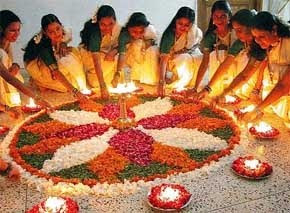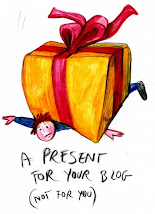
ONAM
Onam is the biggest and the most important festival of the state of Kerala. It is a harvest festival and is celebrated with joy and enthusiasm all over the state by people of all communities. According to a popular legend, the festival is celebrated to welcome King Mahabali, the mythical Asura king of ancient Kerala whose spirit is said to visit Kerala at the time of Onam.
Malayalees believe that on Onam day Bali visits his subjects. Onam is now celebrated by everyone in the region irrespective of any caste or relegion. Onam has become a secular festival of India and can be classified as a celebration after the harvesting season.
 During the reign of mighty asura (demon) king, Mahabali, Kerala witnessed its golden era. Every body in the state was happy and prosperous and king was highly regarded by his subjects. Apart from all his virtues, Mahabali had one shortcoming. He was egoistic. This weakness in Mahabali's character was utilized by Gods to bring an end to his reign as they felt challenged by Mahabali's growing popularity. However, for all the good deed done by Mahabali, God granted him a boon that he could annually visit his people with whom he was so attached. It is this visit of Mahabali that is celebrated as Onam every year.
During the reign of mighty asura (demon) king, Mahabali, Kerala witnessed its golden era. Every body in the state was happy and prosperous and king was highly regarded by his subjects. Apart from all his virtues, Mahabali had one shortcoming. He was egoistic. This weakness in Mahabali's character was utilized by Gods to bring an end to his reign as they felt challenged by Mahabali's growing popularity. However, for all the good deed done by Mahabali, God granted him a boon that he could annually visit his people with whom he was so attached. It is this visit of Mahabali that is celebrated as Onam every year.
 Onam has two specific significances. First it is the memory of community at large and celebration of past history as enunciated in the Mahabali legend – a story of how paradise was lost. Second it is the celebration of the harvest, tied with the memory of the golden age of prosperity. It is believed that during those days the whole of Chingam (welcome month for people in the state of Kerala) was celebrated as Onam season.
Onam has two specific significances. First it is the memory of community at large and celebration of past history as enunciated in the Mahabali legend – a story of how paradise was lost. Second it is the celebration of the harvest, tied with the memory of the golden age of prosperity. It is believed that during those days the whole of Chingam (welcome month for people in the state of Kerala) was celebrated as Onam season.
The festival is the harbinger of spring — signalling the start of the harvest season.

Onam epitomises the newfound vigour and enthusiasm of the season, and is celebrated with traditional fervour with folk games, family get-togethers, gifting of clothes called Onakkodi and lots of merrymaking. Thiruvathira kali is a dance form performed at the time of Onam. Onam is celebrated with flower and sadya (Kerala vegetarian feast).The flowers are decoratively arranged on the floor and clay models of the family of Mahabali are placed in the middle to welcome Mahabali. Intricately decorated Pookalam, ambrosial Onasadya, breathtaking Snake Boat Race and exotic Kaikottikali dance are some of the most remarkable features of Onam - the harvest festival in Kerala.
 Carnival of Onam lasts for ten days and brings out the best of Kerala culture and tradition. First day, Atham and tenth day, Thiruonam are most important of all. Popularity and presentation of rich culture of the state during the carnival made Onam the National Festival of Kerala. Elaborate feasts, folk songs, elegant dances, energetic games, elephants, boats and flowers all are a part of the dynamic festival called Onam. Thousands of domestic and foreign tourists visit Kerala to be a part of Onam.
Carnival of Onam lasts for ten days and brings out the best of Kerala culture and tradition. First day, Atham and tenth day, Thiruonam are most important of all. Popularity and presentation of rich culture of the state during the carnival made Onam the National Festival of Kerala. Elaborate feasts, folk songs, elegant dances, energetic games, elephants, boats and flowers all are a part of the dynamic festival called Onam. Thousands of domestic and foreign tourists visit Kerala to be a part of Onam.
 People make all efforts to celebrate the festival in a grand way and impress upon their dear King that they are happy and wish him well.
People make all efforts to celebrate the festival in a grand way and impress upon their dear King that they are happy and wish him well.
Rich cultural heritage of Kerala comes out in its best form and spirit during the ten day long festival.
It is indeed a treat to be a part of the grand carnival. People of Kerala make elaborate preparations to celebrate it in the best possible manner.

The most impressive part of Onam celebration is the grand feast called Onasadya, prepared on Thiruonam. It is a nine course meal consisting of 11 to 13 essential dishes. Onasadya is served on banana leaves and people sit on a mat laid on the floor to have the meal.

Another enchanting feature of Onam is Vallamkali, the Snake Boat Race, held on the river Pampa. It is a colourful sight to watch the decorated boat oared by hundreds of boatmen amidst chanting of songs and cheering by spectators.

As it is a harvest season, the beautiful state of Kerala can be seen in its magnificent best.Weather is pleasantly sunny and warm calling for mirth and celebrations.Fields look brilliant as they glow with golden paddy grains. It is also the boom time of fruits and flowers.
After the month of deprivation, Karkidakam (last month of Malayalam Calendar), farmers are happy with a bountiful harvest and celebrate the festival to the hilt.
 There is also a tradition to play games, collectively called Onakalikal, on Onam. Men go in for rigorous sports like Talappanthukali (played with ball), Ambeyyal (Archery), Kutukutu and combats called Kayyankali and Attakalam. Women indulge in cultural activities. They make intricately designed flower mats called, Pookalam in the front courtyard of house to welcome King Mahabali. Kaikotti kali and Thumbi Thullal are two graceful dances performed by women on Onam. Folk performances like Kummatti kali and Pulikali add to the zest of celebrations.
There is also a tradition to play games, collectively called Onakalikal, on Onam. Men go in for rigorous sports like Talappanthukali (played with ball), Ambeyyal (Archery), Kutukutu and combats called Kayyankali and Attakalam. Women indulge in cultural activities. They make intricately designed flower mats called, Pookalam in the front courtyard of house to welcome King Mahabali. Kaikotti kali and Thumbi Thullal are two graceful dances performed by women on Onam. Folk performances like Kummatti kali and Pulikali add to the zest of celebrations.
As I have done my Masters from Kerala so I enjoyed Onam very much. And, if experienced once, it is cherished for a lifetime.
Malayalees believe that on Onam day Bali visits his subjects. Onam is now celebrated by everyone in the region irrespective of any caste or relegion. Onam has become a secular festival of India and can be classified as a celebration after the harvesting season.
 During the reign of mighty asura (demon) king, Mahabali, Kerala witnessed its golden era. Every body in the state was happy and prosperous and king was highly regarded by his subjects. Apart from all his virtues, Mahabali had one shortcoming. He was egoistic. This weakness in Mahabali's character was utilized by Gods to bring an end to his reign as they felt challenged by Mahabali's growing popularity. However, for all the good deed done by Mahabali, God granted him a boon that he could annually visit his people with whom he was so attached. It is this visit of Mahabali that is celebrated as Onam every year.
During the reign of mighty asura (demon) king, Mahabali, Kerala witnessed its golden era. Every body in the state was happy and prosperous and king was highly regarded by his subjects. Apart from all his virtues, Mahabali had one shortcoming. He was egoistic. This weakness in Mahabali's character was utilized by Gods to bring an end to his reign as they felt challenged by Mahabali's growing popularity. However, for all the good deed done by Mahabali, God granted him a boon that he could annually visit his people with whom he was so attached. It is this visit of Mahabali that is celebrated as Onam every year. Onam has two specific significances. First it is the memory of community at large and celebration of past history as enunciated in the Mahabali legend – a story of how paradise was lost. Second it is the celebration of the harvest, tied with the memory of the golden age of prosperity. It is believed that during those days the whole of Chingam (welcome month for people in the state of Kerala) was celebrated as Onam season.
Onam has two specific significances. First it is the memory of community at large and celebration of past history as enunciated in the Mahabali legend – a story of how paradise was lost. Second it is the celebration of the harvest, tied with the memory of the golden age of prosperity. It is believed that during those days the whole of Chingam (welcome month for people in the state of Kerala) was celebrated as Onam season. The festival is the harbinger of spring — signalling the start of the harvest season.

Onam epitomises the newfound vigour and enthusiasm of the season, and is celebrated with traditional fervour with folk games, family get-togethers, gifting of clothes called Onakkodi and lots of merrymaking. Thiruvathira kali is a dance form performed at the time of Onam. Onam is celebrated with flower and sadya (Kerala vegetarian feast).The flowers are decoratively arranged on the floor and clay models of the family of Mahabali are placed in the middle to welcome Mahabali. Intricately decorated Pookalam, ambrosial Onasadya, breathtaking Snake Boat Race and exotic Kaikottikali dance are some of the most remarkable features of Onam - the harvest festival in Kerala.
 Carnival of Onam lasts for ten days and brings out the best of Kerala culture and tradition. First day, Atham and tenth day, Thiruonam are most important of all. Popularity and presentation of rich culture of the state during the carnival made Onam the National Festival of Kerala. Elaborate feasts, folk songs, elegant dances, energetic games, elephants, boats and flowers all are a part of the dynamic festival called Onam. Thousands of domestic and foreign tourists visit Kerala to be a part of Onam.
Carnival of Onam lasts for ten days and brings out the best of Kerala culture and tradition. First day, Atham and tenth day, Thiruonam are most important of all. Popularity and presentation of rich culture of the state during the carnival made Onam the National Festival of Kerala. Elaborate feasts, folk songs, elegant dances, energetic games, elephants, boats and flowers all are a part of the dynamic festival called Onam. Thousands of domestic and foreign tourists visit Kerala to be a part of Onam.  People make all efforts to celebrate the festival in a grand way and impress upon their dear King that they are happy and wish him well.
People make all efforts to celebrate the festival in a grand way and impress upon their dear King that they are happy and wish him well.Rich cultural heritage of Kerala comes out in its best form and spirit during the ten day long festival.
It is indeed a treat to be a part of the grand carnival. People of Kerala make elaborate preparations to celebrate it in the best possible manner.

The most impressive part of Onam celebration is the grand feast called Onasadya, prepared on Thiruonam. It is a nine course meal consisting of 11 to 13 essential dishes. Onasadya is served on banana leaves and people sit on a mat laid on the floor to have the meal.

Another enchanting feature of Onam is Vallamkali, the Snake Boat Race, held on the river Pampa. It is a colourful sight to watch the decorated boat oared by hundreds of boatmen amidst chanting of songs and cheering by spectators.

As it is a harvest season, the beautiful state of Kerala can be seen in its magnificent best.Weather is pleasantly sunny and warm calling for mirth and celebrations.Fields look brilliant as they glow with golden paddy grains. It is also the boom time of fruits and flowers.
After the month of deprivation, Karkidakam (last month of Malayalam Calendar), farmers are happy with a bountiful harvest and celebrate the festival to the hilt.
 There is also a tradition to play games, collectively called Onakalikal, on Onam. Men go in for rigorous sports like Talappanthukali (played with ball), Ambeyyal (Archery), Kutukutu and combats called Kayyankali and Attakalam. Women indulge in cultural activities. They make intricately designed flower mats called, Pookalam in the front courtyard of house to welcome King Mahabali. Kaikotti kali and Thumbi Thullal are two graceful dances performed by women on Onam. Folk performances like Kummatti kali and Pulikali add to the zest of celebrations.
There is also a tradition to play games, collectively called Onakalikal, on Onam. Men go in for rigorous sports like Talappanthukali (played with ball), Ambeyyal (Archery), Kutukutu and combats called Kayyankali and Attakalam. Women indulge in cultural activities. They make intricately designed flower mats called, Pookalam in the front courtyard of house to welcome King Mahabali. Kaikotti kali and Thumbi Thullal are two graceful dances performed by women on Onam. Folk performances like Kummatti kali and Pulikali add to the zest of celebrations.As I have done my Masters from Kerala so I enjoyed Onam very much. And, if experienced once, it is cherished for a lifetime.







































